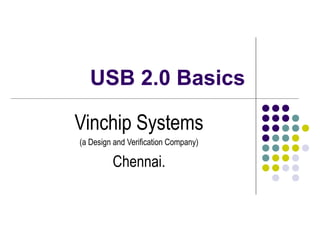
USB 2.0 Basics: Architecture, Protocol Layers & Communication Flow
- 1. USB 2.0 Basics Vinchip Systems (a Design and Verification Company) Chennai.
- 2. Universal Serial Bus History of USB Why We Need USB ? Architectural Overview USB communication flow Protocol Layer Conclusion
- 3. History of USB Universal Serial Bus (USB) is an industry standard developed in the mid-1990 USB was designed to standardize the connection of computer peripherals Keyboard Mouse Digital cameras Printers Portable media players HD drives Mobile devices PDA
- 4. Overview Key features of USB: Low cost Single connector type Hot pluggable Device handling Cable power
- 5. USB Three generations of USB USB 1.0 USB 2.0 USB 3.0 and WUSB
- 6. Version History Prereleases The USB standard evolved through several versions before its official release in 1995: USB 0.7: Released in November 1994. USB 0.8: Released in December 1994. USB 0.9: Released in April 1995. USB 0.99: Released in August 1995. USB 1.0 Released in January 1996. USB 2.0: Released in April 2000 USB 3.0 was released in November 2008.
- 8. Why We Need USB ? Connection of the PC to the telephone : =>In order to transmit data Ease-of-use : =>Support plug and play Port expansion : =>Up to 127 devices =>Can add lots of device to a XX The logical topology of the USB is a star structure It is similar to computer network
- 9. USB Can Do Combines low speed and high speed bus activity , USB enables shared access for both speed Automatic configuring of devices and a serial bus which is simplified and easy to plug into Attach / detach easily without restarting system
- 10. USB 2.0 Specs USB 2.0: Released in April 2000 maximum signaling rate of 480 Mbit/s effective throughput up to 35 MB/s Mini-A Mini-B Connector
- 11. Architectural Overview USB System Member - 1 USB System Member - 2 USB System Member - 3
- 12. USB System Member - 1 Host : only one The smartest element in the USB system Responsible to the complexity of the protocol to make devices design simple and low cost Control the media access ( no one can Access the bus unless it get an approval required from the host )
- 13. USB System Member - 2 Hub: one or more =>Like the hubs used for computer network =>Enables many devices to connect to a single USB port
- 14. USB System Member - 3 Device : one or more =>Everything in the USB system , which is not a host , is a device ( include hubs) =>A device may provides one or more USB functions =>Has an unique address at the end of the enumeration process
- 16. Pipes (1) The logic communication between the client software on the host and the function on the device is done through pipes It is a association between a specific endpoint on the device and the appropriate software in the host
- 17. Pipes (2) An endpoint is the source or destination of the data that transmitted on the USB cable Two direction =>OUT : data flows from the host to the device =>IN : data flows from the device to the host
- 19. Signaling On The Bus The USB cable is 4 wire cable Signal on the bus is done by signaling over tow wires ( D+ and D_ ) 1 : D_ low , D+ high 0 : D_ high , D+ low Data encoding and decoding is done using NRZI ( Non Return to Zero Inverted )
- 20. SIE - Serial Interface Engine SIE : Serial Interface Engine It is part of both the host’s and the device’s physical layer Serialization and Deserialization Encoding and Decoding Generate (for out) and Verify (for in) CRC
- 21. HC -Host Controller It is an additional hardware to ensure that everything which is transmitted on the bus is correct It serves both the USB and the host and has the same functionality in ever USB system
- 22. Transaction USB transactions are done through packets include three phases Token phase : host initiates token indicating the future transfer type Data phase : Actual data transmitted Handshake phase : Indicate the success or failure of the transaction
- 23. Transfer Types (1) Control Transfer =>Used to configure a device (enumeration) =>Compose of three phases (setup, data, status) Isochronous Transfer =>Used for multimedia devices =>It is guarantee the required bandwidth =>No handshake phase
- 24. Transfer Types (2) Bulk Transfer =>Used for large burst data =>Guarantee of delivery , no guarantee of bandwidth or minimum latency Interrupt Transfer =>If there is a pending interrupt , the function will send details to host after host poll it
- 25. Packet (1) PID : Packet Identifier Field Address Field =>So , there are up to 127 devices in USB
- 26. Packet Data Packet Handshake Packet =>Such as ACK 、 NAK 、 STALL…etc.
- 27. Conclusion USB is powerful and easy to use The complex host make the device easy to design
- 28. Cable
- 29. NRZI (1) Want to transmit : =>1 : without changing the level of the level of the signaling =>0 : flip the value of the differential pair example :
- 30. NRZI (2) Problem : When we send “1” stream , the transmission line will stay static ( no change period ) Solution : “Bit stuffing” , performed before the NRZI example : data : 010111111101 send : 0101111110101
